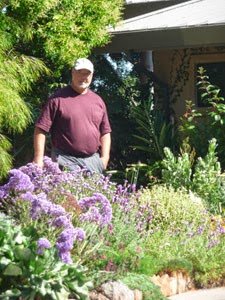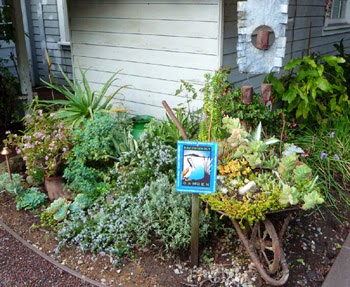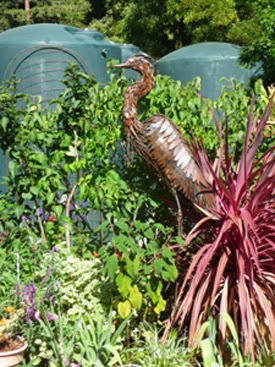Link to Original Article

Lately in observing my garden, and talking with friends and clients, I’ve noticed how gardens everywhere are
showing early signs of summer water stress. This year, normal spring growth was early and brief. Now, even established plants are wilting on hot days. Welcome to our third dry year in a row!
There’s good news from the drought- the folks I talk to are more open than ever to water-wise gardening, and giving more thought and attention to how they use water in our naturally dry state. Many are searching for innovative ways to conserve, like grey water and rain catchment systems.
When clients ask for advice, I tend to steer them towards the basics, like dialing back the sprinkler timer or cutting down on in-door use. But what’s next, if you’ve already taken these good first steps or hesitate to invest in an elaborate grey water or rain catchment system?
One of the first questions I ask homeowners in this situation is: Are you in love with your lawn and can you live without it? Close to 50% of water used in the average California garden goes to it’s ubiquitous green sward, and unless you have small children or pets at home, I see that thirsty, high-maintenance lawn as a pretty but useless outdoor carpet! Why not free up all that water by curtailing or eliminating lawn watering for the summer? You know you hate mowing it! This will free up a chunk of your water budget for those struggling and slower growing trees, shrubs and perennials that could really use some extra help in this ultra-dry year. In comparison, lawns are relatively easy and inexpensive to replace, and when fall rolls around you might opt for one of the new no-mow or native grass mixtures now available, or maybe replace it with a drought-tolerant ground cover that will lower your water bill for years to come!
Here’s where I get to the part about how and when it makes sense to use water in a drought: If you’ve found ways to cut back on non-essential water use or let your lawn go, you may now have a bit of water available to use where it’s most needed- like those wilting shrubs and trees. Remember you’ve probably been watering them indirectly for years, along with the lawn. Established plants often have extensive root systems capable of pulling in some of that water you’ve lavished on the turf. If you plan on cutting back on lawn watering, I recommend getting a small hose-end sprinkler and running it at low pressure in perennial borders and under trees and shrubs. Set a timer and move it every 15 minutes, so that those areas get a good soak. Water in the cooler parts of the day, three or four times during the summer, and your valuable landscape plants will come through this dry time in better shape.
Another idea that I use in my own home is to create an “oasis”. This is an area I’ve strategically chosen just outside my kitchen window that gets plenty of sunshine and some of the extra water I’ve saved by cutting back in other areas. For this concentrated space, I’ve chosen lots of long-flowering and nectar-rich plants, and included a low birdbath that I clean and fill daily. The result is a colorful parade of insects, birds and even animals that are drawn in for the precious water and scarce food. I was at the sink the other evening at dusk, and was surprised to see a junior-sized skunk waddle up to the birdbath and delicately lap up a bit of the water before trundling on. In my experience, skunks are polite garden visitors (if you have the good sense not to startle them), and in their search for food have provided the valuable service of finding and destroying any yellow jacket nests lurking around the edges of my garden. One good turn deserves another- seems like nature’s way!
The prolonged drought that we are currently experiencing has a silver lining. As we grow in numbers and technological power, Californians are http://essay-it.com/ being reminded that we are still a part of nature. Learning Her lessons of respect, interconnection and interdependence bodes well for our future.
If you are interested in reading more about landscaping and water conservation click here.
The comments are closed.


No comments yet